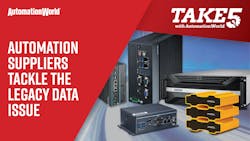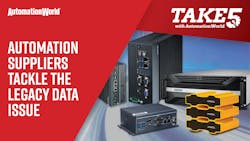Automation Suppliers Tackle the Legacy Data Issue

Quick hits:
- Learn about the partnership between Advantech and Hivecell to collect equipment data collected for processing by machine learning and other analytic software.
- How industry uses a hybrid cloud/edge approach for data collection and analysis.
- How the Google Cloud and Litmus partnership simplifies the process of collecting data from disparate factory devices to connect it to Google Cloud data and artificial intelligence applications.
Welcome to Take Five with Automation World. I’m David Greenfield, Director of Content, and today we’re going to look at how automation suppliers are confronting legacy data collection issues.
One of the biggest challenges of the digital transformation for manufacturers and processors is accessing data from legacy production systems and connecting them for analytic insights. The good news is that solving this problem is a major area of focus for suppliers of both hardware and software automation technologies. And the development of two recent, major partnerships really highlight how much effort is being put into this issue to help manufacturers.
One of these partnerships is between Advantech and Hivecell. In this case, the companies are combining Advantech’s industrial hardware and Hivecell’s edge as a service platform to ease the process of connecting legacy systems to gateways, edge computers, 5G routers, and other Internet of Things devices for scalable data management. In this technology partnership, IoT gateways act as the bridge between legacy devices and the network, converting physical information into digital data for transmission from the edge. Raw equipment data collected at the edge is processed by machine learning and other analytic software. By collecting and processing data at the edge, Hivecell says the flow of data for analysis is improved because it allows for non-relevant data to be discarded on site so that only relevant data is sent to enterprise systems or the cloud for further processing.
According to Advantech, the enormous amounts of data generated by connecting production systems can be an obstacle to efficient operations if end users depend on cloud- only processing. The company notes that, while the cloud clearly has value as a storage space and for longer time-scale analytics, it can’t really enable the day-to-day operational and safety improvements that edge as a service technologies make possible for more real-time decision-making.
Advantech products recommended for use with Hivecell’s edge as a service platform, include the UNO-238 compact IoT edge computer, the UNO-148 DIN-rail control computer, the SKY-640 V2 rackmount scalable GPU server, and the MIC-770 V2 compact fanless computer.
If there’s one thing industry’s embrace of cloud and edge computing technologies has shown us, it’s that hybrid systems—using both cloud and edge computing to handle data storage and analytics—are the preferred approach. As we saw in a 2019 Automation World study, digital transformation initiatives tend to follow a typical rollout pattern: Phase one is usually centered around the cloud to host core enterprise analytics applications to evaluate plant performance or for asset optimization to reduce production downtime. From there, manufacturers tend to invest in edge computing technologies for detailed onsite analytics delivered in near real time. The cloud also figures in here in as a means of providing additional storage and compute scalability.
This hybrid reality of cloud and edge computing is highlighted in the development of the Manufacturing Connect platform by Google Cloud and Litmus, a supplier of industrial edge computing technologies. The idea behind the Manufacturing Connect platform is to simplify the process of collecting data from disparate factory devices and exposing it to Google Cloud data and artificial intelligence applications.
According to Litmus, Manufacturing Connect is a factory edge platform designed to support more than 250 machine communication protocols. Data is structured and stored locally and then sent to Google Cloud for analysis. The platform can also deploy and manage artificial intelligence and machine learning models at the edge.
Features of the Manufacturing Connect platform include data collection and engineering, data visualizations and key performance indicator dashboards, containerized application deployment, and a machine learning model runtime. It also includes out-of-the-box integration with several analytics packages, such as Looker for business intelligence and analytics, and Vertex AI for machine learning applications.”
Explaining how Litmus Edge prepares data for Google Cloud analytics, Vatsal Shah, the CEO at Litmus, says, “We collect data from industrial systems, normalize that data, and add all of the operations technology data variables for context locally. We then push that data into the Google Cloud environment using the publish/subscribe communication method, allowing Google to add more contextualized data at the enterprise level, such as from MES or ERP systems. The structured final data point is then ready to use for analytics. He notes that all of this happens automatically, but can be configured by the user if they want to change anything.
So I hope this Take Five episode helped you better understand how technology suppliers are working to make the digital transformation process easier for you.
